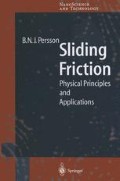Abstract
In Chap. 12 we studied sliding dynamics for lubricated surfaces. We have emphasized several times that most “real” surfaces are lubricated, e.g., by a layer of grease, even if no lubrication fluid has been intentionally added to the system. Nevertheless, in some cases the increase of the static friction force with the time of stationary contact, due to the processes discussed in Chap. 12, may be negligible; we will refer to these systems as exhibiting “dry” friction. Dry friction may prevail for many surfaces lubricated by fatty acids; because of the high local pressures which occur in the contact areas between, e.g., two steel surfaces, the relaxation time for interdiffusion and other rearrangement processes may be very long (Sects. 7.2,6) so that a negligible increase in the static friction force may occur during a typical stick-time period, in which case the static friction nearly equals the kinetic friction, as indeed observed in many cases (Table 7.5). But even in the case of “dry” friction, the static friction force may increase with time due to an increase in the area of real contact which occurs in many real systems for the reasons discussed in Chap. 5 and below.
Access this chapter
Tax calculation will be finalised at checkout
Purchases are for personal use only
Preview
Unable to display preview. Download preview PDF.
Reference
F. Heslot, T. Baumberger, B. Perrin, B. Caroli, C. Caroli: Phys. Rev. E 49, 4973 (1994)
T. Baumbergen, F. Heslot, B. Perrin: Natuer 367, 544 (1994)
T. Baumbergen, C. Caroli, B. Perrin, O. Ronsin: Phys. Rev. E 51, 4005 (1995)
T. Baumbergen, C. Caroli: Commen. Cond. Mat. Phys. 17, 306 (1995)
C.H. Scholz, T. Engeldaard: Int’1 J. Rock. Mech. Min. Sci. 13, 149 (1976)
J.H. Dietrich, B.D. Kilgore: PAGEOPH 143, 283 (1994)
T. Baumbergen, C. Caroli: Commen. Cond. Mat. Phys. 17, 281 (1995)
A. Johansen, P. Dimon, C. Ellegaard, J.S. Larsen, H.H. Rugh: Phys. Rev. E 48, 4779 (1993)
Y. Braiman, F. Family, G. Hentschel: Phys. Rev. E 53, R3005 (1996) M.G. Rozman, J. Klafter, M. Urbakh: In Micro/Nanotribology and itsApplications, ed. by B. Bhushan (Kluwer, Dordrecht 1997 ) F.J. Elmer: In Physics of Sliding Friction, ed. by B.N.J. Persson, E. Tosatti ( Kluwer, Dordrecht 1996 )
Author information
Authors and Affiliations
Rights and permissions
Copyright information
© 1998 Springer-Verlag Berlin Heidelberg
About this chapter
Cite this chapter
Persson, B.N.J. (1998). Dry Friction Dynamics. In: Sliding Friction. NanoScience and Technology. Springer, Berlin, Heidelberg. https://doi.org/10.1007/978-3-662-03646-4_13
Download citation
DOI: https://doi.org/10.1007/978-3-662-03646-4_13
Publisher Name: Springer, Berlin, Heidelberg
Print ISBN: 978-3-662-03648-8
Online ISBN: 978-3-662-03646-4
eBook Packages: Springer Book Archive

